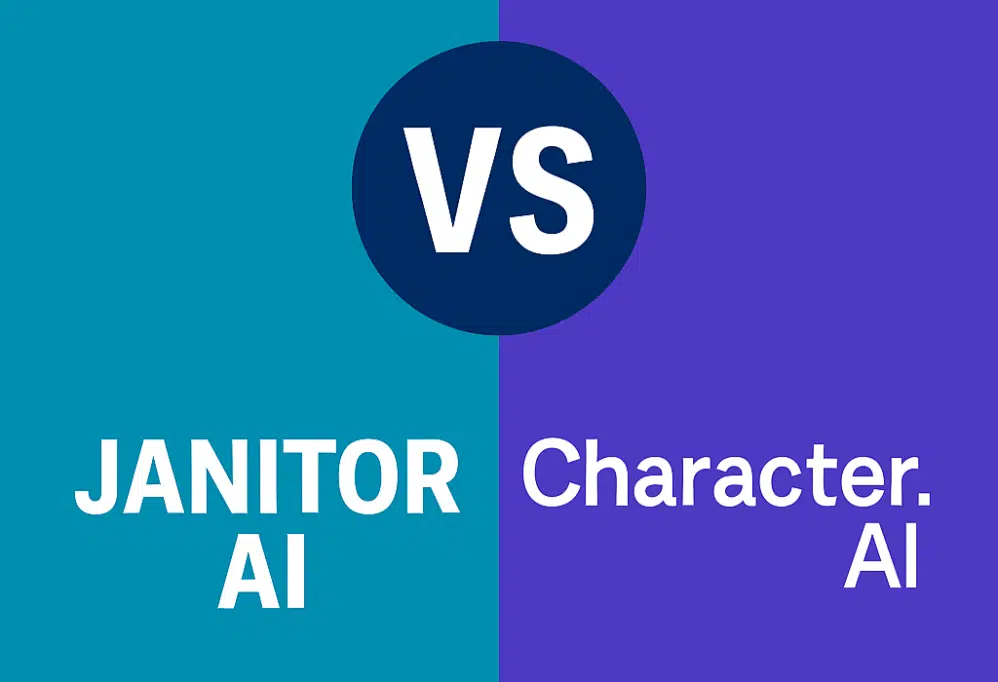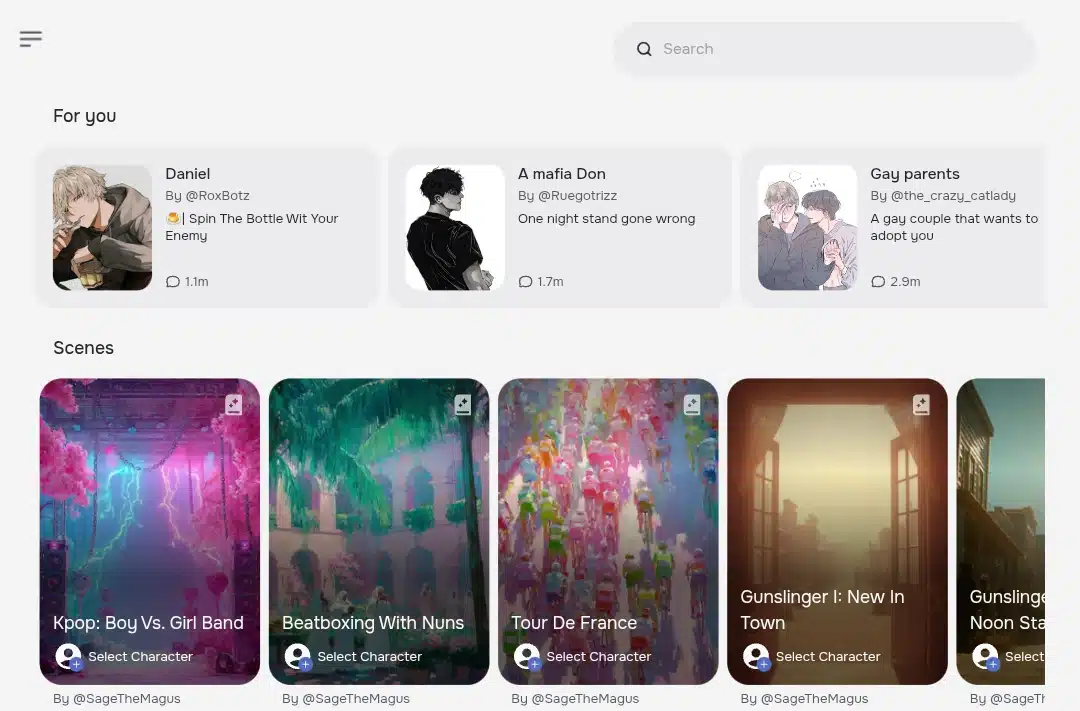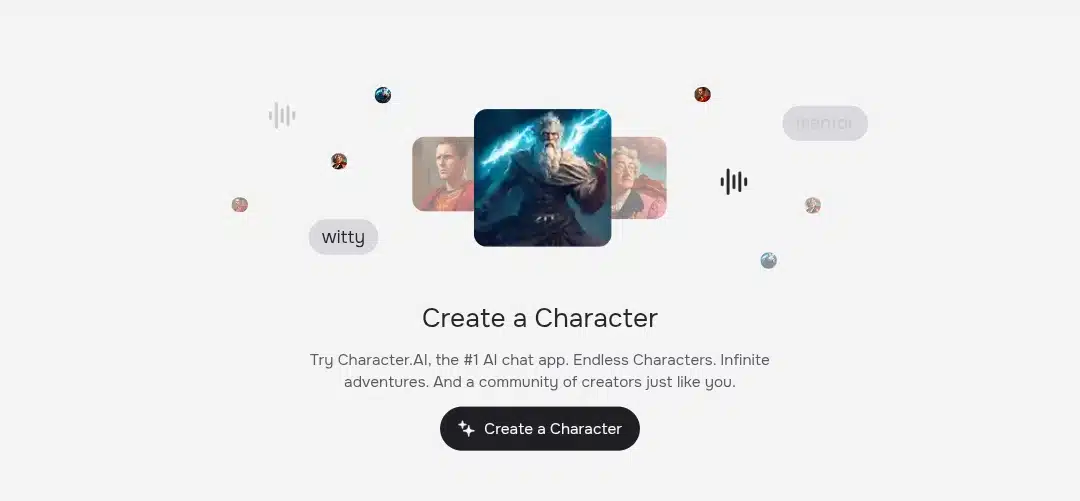
Talking to an AI chatbot today isn’t what it used to be. Sometimes, it comes off as if you’re not speaking to a human! With platforms like Janitor AI and Character.AI, it can feel uncannily close to chatting with a real person. One with opinions, memory, and personality because they don’t just respond but engage, reflect your tone, ask questions, and stay in character.
Yet, just like people, these two chatbots have very different styles. While Character.AI flows on structured, consistent conversations with characters that remember you over time, Janitor AI, on the other hand, offers more freedom, fewer filters, greater model flexibility, and a community-first approach.
If you enjoy creating characters, exploring roleplay, or just want an AI companion that suits your pace and personality, this comparison breaks it down. Let’s explore how these two tools perform, where they excel, where they don’t, and which one might better fit you.
There’s more below!
Key takeaways
- Character.AI and Janitor AI offer immersive, human-like interactions beyond basic chatbot replies.
- Both platforms support deep character creation. Character.AI leans into refined personality design, while Janitor AI thrives on user-shared and experimental characters.
- Janitor AI supports external models. From OpenAI to KoboldAI, users can switch engines for different conversational behaviors and performance.
- Character.AI offers a premium upgrade (c.ai+). Paid users get better memory, faster access, ad-free chats, and more control over responses and style.
- The community experience differs greatly. Janitor AI is socially active with Discord and events. Character.AI is more solitary, focused on one-on-one roleplay.
- Janitor AI gives you more freedom and flexibility. It allows NSFW content, broader topics, and customizable models for users with fewer limits.
- Your perfect pick depends on your priorities. So, choose Character.AI for safe, consistent storytelling. And Janitor AI if you want open-ended, community-driven interaction.
What is Janitor AI?

Janitor AI is a character-based AI chatbot platform that allows users to create, customize, and interact with fictional personas powered by advanced language models. It’s especially popular among roleplayers, content creators, and gamers who want more freedom in communicating with AI characters, including the option to engage in NSFW (Not Safe for Work) conversations.
Unlike platforms that rely on a single AI engine, Janitor AI provides users with multiple options to enhance their chatbot experience. These methods are often referred to as “types” of Janitor AI, and each comes with different levels of customization, complexity, and output quality. See them below:
The 3 integration types of Janitor AI
1. JanitorLLM (Beta)
This is Janitor AI’s built-in language model and needs no third-party setup or API key. It’s beginner-friendly, quick to start, and suitable for users who want to test the platform with minimal configuration. While still in beta, JanitorLLM delivers decent conversational quality and works well for basic role-play and general interactions.
JanitorLLM (Beta) pros
- No API key or setup required.
- Beginner-friendly.
- Fast access to characters.
- Good for basic conversations and casual roleplay.
JanitorLLM (Beta) cons
- Still in beta (may have bugs or limits).
- Memory and context retention are weaker than other options.
- Limited model strength compared to OpenAI.
- May struggle with complex or nuanced responses.
2. OpenAI API
Using a personal API key, this method connects Janitor AI to OpenAI’s models (like GPT-3.5 or GPT-4). It delivers high-quality, coherent, and creative outputs. It is ideal for users who want a powerful AI experience with reliable memory and context handling, but it requires an OpenAI account and active credit.
OpenAI API pros
- Excellent conversation quality.
- Strong memory and contextual understanding.
- Supports long-form interactions.
- Ideal for immersive character building.
OpenAI API cons
- Requires an OpenAI account and billing setup.
- Usage may consume credits quickly.
- Some censorship may still apply depending on model tuning.
- API setup can be intimidating for new users.
3. KoboldAI
KoboldAI is an open-source interface that allows users to link Janitor AI with locally hosted or third-party AI models like Pygmalion, GPT-J, or Erebus. This setup is favored by advanced users and the NSFW roleplay community due to its customization flexibility, uncensored outputs, and offline hosting options. However, it requires more technical know-how and configuration time.
KoboldAI pros
- Whole uncensored experience (depending on the model).
- Offline hosting is possible.
- Supports unique models like Pygmalion.
- Deep customization and prompt tuning.
KoboldAI cons
- Requires setup knowledge and possibly hardware resources.
- Slower response time in some setups.
- The interface may be less stable.
- Limited support for beginners.
What is Character.AI?

Character.ai is an AI chatbot platform powered by advanced language models developed by former Google researchers, allowing users to interact with characters. Each character is designed with a unique personality, behavior, and conversational style.
Unlike platforms that allow external AI model integration, Character.AI runs on its own proprietary models. These models are specifically trained for personality simulation, enabling intelligent, context-aware conversations that feel lifelike and expressive. The system is built to respond in ways that align with a character’s defined traits, rather than generating random or generic replies.
A standout aspect of Character.ai is its focus on safe and moderated interactions. All conversations are filtered to remain appropriate, and the platform is structured to be accessible to a broad audience. This makes it a strong fit for educational use, casual creative expression, or anyone interested in exploring character-driven dialogue in a controlled environment.
Another unique element is the strong community involvement. Users can chat with AI personas and create and publish their own characters. They can then share their creations with others, helping grow a dynamic user-generated content ecosystem.
Character.ai is designed to be accessible, offering a conversational environment that emphasizes creativity, engagement, and role-specific interaction. The platform has become especially popular among gamers, writers, and creatives who enjoy interacting with fictional personas or designing their own, as well as anyone interested in personality simulation through AI-driven dialogue.
Janitor AI core features
1. Model flexibility and external API integration
Janitor AI stands out for allowing you to choose the AI model behind the chatbot. You can use the built-in JanitorLLM, connect to OpenAI’s GPT, or run local models via KoboldAI. Each option affects speed, quality, and censorship. This flexibility appeals if you want control over the chatbot’s behavior.
2. NSFW toggle and censorship control

Unlike many platforms, Janitor AI offers an optional NSFW toggle that lets you explore more adult, dark, or unconventional themes. Whether you’re building a horror scenario or mature roleplay, you control the limits. This openness makes it a go-to for adults who want complete narrative freedom. Censorship is minimal by design.
3. Deep customization of personality and chat style
You can readjust each character’s behavior, including tone, randomness, memory strength, and role descriptions. You’re able to tweak the system prompt, temperature, and even the AI’s logic style. Janitor AI encourages experimentation and iteration. It’s ideal if you want full creative input and flexible storytelling.
4. Strong community and character sharing
The platform’s character library is community-powered, with thousands of user-submitted bots. You can clone, remix, or build upon existing characters from anime icons to original fantasy figures. This promotes collaboration and makes discovery easy. Combined with Discord-based support, the experience feels open, social, and evolving.
Character.AI key features
1. Personality-driven AI chats
Character.AI allows you to create interactive characters with distinct personalities, backstories, and communication styles. Whether you’re building a fantasy warrior or a therapist bot, you define how it talks and reacts. Its system learns through your input and interaction, improving over time. This makes character engagement deeply immersive and personal.
2. Long-term memory and context awareness
The platform excels at keeping up with long conversations. Characters remember details about past chats, quirks, or shared experiences, enhancing consistency. With recent upgrades, the memory capacity has improved significantly. This makes storytelling and emotional development feel continuous and believable.
3. Availability of tools for fast and advanced character building

Character.AI supports quick-start character creation and gives you access to advanced editing tools. You can set greeting messages, dialogue examples, emotional tones, and specific reaction patterns. This gives both casual creators and world-builders serious control over character depth. It’s ideal for roleplay, writing, and fan-fiction lovers.
4. Multimodal and mobile integration
Beyond chat, Character.AI is evolving into a creative suite. Its mobile app supports video sticker creation, avatar generation, and character “scenes.” You can access your chats on the go or share animated characters in conversations. This versatility makes the platform attractive for both fun and storytelling.
A detailed comparison of Janitor AI vs Character.AI across key aspects
1. Character creation
Character creation is the foundation of both platforms, but each handles it differently.
Character.ai is built for precision and depth. It lets users define detailed character backgrounds, tone of voice, emotional responses, and interaction style. The character creation tool encourages writers and roleplayers to build nuanced AI personalities with logic and backstory. The interface supports advanced fields for defining behavior in specific scenarios, giving creators complete control over how their character should think and speak.
Janitor AI takes a more flexible and community-driven approach. While users can also define traits and settings, the platform leans into quick-start customization and character sharing. Users frequently remix each other’s creations, and the lack of strict moderation allows for a broader range of personas—including those considered off-limits on Character.ai. While it may not offer as much structure during creation, it appeals to creators who value freedom and speed over rigidity.
Takeaway: Character.ai favors structure and storytelling control. Janitor AI promotes open, fast-paced creation and community collaboration.
2. Memory and context retention
Strong memory allows for immersive, natural conversations.
Character.ai performs well in this area, maintaining context over more extended conversations. Characters can reference earlier messages within the same session, helping users feel continuity in tone, personality, and theme. This feature is handy for long-form storytelling or when users test consistency in behavior across multiple interactions.
Janitor AI’s memory retention depends on the model used.
- JanitorLLM has a shorter memory, often losing detail after 15–20 messages.
- The OpenAI API integration offers superior memory, especially with GPT-4, and consistently handles callbacks, names, and tone shifts.
- KoboldAI provides moderate memory and can perform well with prompt engineering, but may require manual effort for longer threads.
Takeaway: Character.ai and Janitor AI (OpenAI) are strong choices for consistent memory and character awareness. JanitorLLM trails slightly behind.
3. Personalization
Personalization makes the AI feel responsive to individual users.
Character.ai enables users to build a relationship with their characters over time. While memory resets between sessions, the platform excels at keeping interactions character-faithful. Characters develop believable “reactions” based on tone and prompt, allowing for emotionally intelligent engagement.
Janitor AI emphasizes configurability. Users can mold AI personalities and test different behavioral responses more freely. Especially with KoboldAI or OpenAI models, users can fine-tune character reactions with system prompts and role parameters, adjusting tone and behavior mid-conversation. This flexibility is beneficial for adult-themed or niche personality tests.
Takeaway: Character.ai excels in emotional consistency. Janitor AI allows for greater experimental control and behavioral tweaking.
4. Conversation quality
This is a significant point of distinction between the platforms.
Character.ai delivers fluid, expressive, and often creative replies. It’s designed to stay in character, produce natural-sounding dialogue, and mimic the rhythms of real conversation. This makes it ideal for users focused on narrative quality, roleplay immersion, or personality accuracy.
Janitor AI depends on which backend model is selected.
JanitorLLM tends to produce simpler, more generic responses.
OpenAI API delivers high-level conversation quality, with fast, coherent, and intelligent replies.
KoboldAI is suitable for genre-specific roleplay, especially with models like Pygmalion, but its performance varies based on user input quality and server performance.
Takeaway: Character.ai leads in narrative depth. For fast, flexible answers, Janitor AI (OpenAI) is highly effective.
5. Censorship
This is perhaps the most obvious contrast between the two platforms.
Character.ai enforces strict moderation guidelines to ensure a safe and controlled environment. The system actively filters or rephrases messages that involve sensitive, controversial, or explicit themes, including NSFW content. This design makes it suitable for younger audiences, educators, and general users who prefer a moderated space. However, some users find these boundaries too restrictive, especially in creative storytelling or fandom-based roleplay, where certain tropes or dialogue types may be blocked or flagged.
Janitor AI, by contrast, is known for its minimal to no censorship. It allows open-topic conversations, including those that explore darker or more mature themes such as horror, taboo narratives, or adult content. This flexibility attracts a large base of users seeking storytelling without boundaries or creative interference. While it offers freedom, it also places the responsibility of safe engagement on the user, making it better suited to mature audiences.
Takeaway: Character.ai prioritizes safety, structure, and broad accessibility. Janitor AI supports uninhibited expression and adult-level creative freedom.
6. User control
Both platforms offer tools that allow users to shape their experiences and manage their data responsibly.
Character.ai provides users with standard controls such as opt-out settings, the ability to reset or delete conversations, and the option to manage saved characters. The platform also outlines how user data is processed, ensuring transparency around what is stored and how it may be used. However, some of these settings are nested within menus, which may require some navigation for newer users.
Janitor AI goes a step further in simplifying and surfacing these privacy tools. Its dashboard is built with clarity in mind, making it easier for users to find and adjust data sharing preferences, clear chat logs, and switch between different AI models depending on preference or use case. Some versions of Janitor AI even allow integration with APIs or external models, granting a deeper level of personalization and user-led configuration.
Takeaway: Both platforms support user autonomy, but Janitor AI presents a more beginner-friendly experience with quicker access to controls and model-level flexibility.
7. User types
The type of users drawn to each platform often reflects their design philosophies and feature sets.
Character.ai is a favorite among younger audiences, writers, and roleplayers who enjoy immersive, structured storytelling. It appeals strongly to users who prioritize fictional interactions, emotional depth, and strong character consistency. Many users engage with characters inspired by anime, literature, or pop culture, creating safe and creative experiences. Because of its moderation policies, it’s also a trusted platform for educators or younger creators.
Janitor AI, meanwhile, appeals to an older, more exploratory audience. This includes adult roleplayers, experimental writers, and users who prefer open-ended dialogue without content restrictions. Its flexible backend configurations make it ideal for developers, researchers, and advanced users who want to push AI in unconventional directions. The platform also draws in those who value strong community features and real-time collaboration, such as group storytelling or event-based chats.
Takeaway: Character.ai is ideal for structured, emotionally safe storytelling among young creatives. Janitor AI is built for adults, power users, and anyone seeking flexibility beyond the boundaries of traditional AI platforms.
8. Community size and engagement
Community plays a vital role in how users discover, share, and interact with AI-generated content.
Character.ai maintains a steadily growing community through its official forums and user-created character libraries. These tools allow creators to showcase their characters, exchange feedback, and explore what others have built. However, community interaction mostly happens around the characters, not within large social spaces. While the platform encourages sharing, its overall structure promotes individual experiences more than real-time social engagement.
Janitor AI fosters a highly active and social environment, primarily through its Discord server, which boasts over 100,000 members. Here, users share characters and ideas and participate in themed roleplay rooms, beta testing, and live discussions. Events, character showcases, and regular updates keep the user base engaged and returning. This makes Janitor AI feel more like a creative hub or social platform than a solo tool.
Takeaway: Janitor AI provides a vibrant, collaborative space for interaction and creativity. Character.ai, while rich in content, supports a more independent and introspective user experience.
9. User interface
User experience is significantly shaped by how the platform is designed and how easily users can navigate it.
Character.ai offers a clean, minimal interface that focuses attention on conversation. The UI is modern, responsive, and distraction-free. Character discovery is organized into categories, and users can quickly access trending bots, saved chats, and their own creations. The advanced search functionality allows filters by character type, theme, or popularity. These design elements create a fluid experience, ideal for solo storytelling or immersive sessions.
Janitor AI leans into a community-first interface. Its layout highlights shared content, Discord links, and trending characters more prominently than fine-tuned search tools. While not as polished as Character.ai, the interface prioritizes easy access and quick onboarding. Buttons to start chats, browse community favorites, or integrate with external models are easy to find. This setup appeals to users who want to jump right in without initially configuring too much.
Takeaway: Character.ai delivers a sleeker, more refined UI ideal for individual focus. Janitor AI offers a looser, faster-paced layout that complements social exploration and creative collaboration.
10. Privacy and security
Both platforms take data privacy seriously, but differ in how they communicate it to users.
Character.ai implements industry-standard security practices, including end-to-end encryption, secure data storage, and limited personal data retention. The platform is designed with GDPR compliance in mind and includes terms that cover how characters, chats, and account data are processed. While the protections are strong, navigating the full privacy settings may require going through several menu layers or external documents, which can make control feel distant to some users.
Janitor AI, on the other hand, prioritizes transparency and accessibility. Its privacy settings are presented in simpler language and are easily located from the main dashboard. Users can delete conversations, turn off tracking, or switch models with fewer steps. This visibility fosters trust, particularly among casual users or those concerned about how their AI-generated content is stored and managed. The platform also emphasizes flexibility in data handling, with clearer options for opting in or out of features.
Takeaway: Both platforms are privacy-conscious, but Janitor AI offers a more user-friendly, accessible approach to managing personal data and settings.
11. Pricing
Character.AI and Janitor AI offer free access, but their premium tiers differ in setup, benefits, and flexibility.
Character.ai uses a simple paid tier known as c.ai+. Upgrading to c.ai+ costs $9.99 per month or $94.99 per year, which saves $24.89 annually. The plan auto-renews but can be canceled anytime.
Subscribers get access to improved memory performance, allowing characters to retain more information and update more frequently. The plan also includes priority chat access, which helps users skip slowdowns during busy hours. With advanced chat styles, users engage with Character.ai’s most refined models.
Other benefits include extended usage limits, such as longer personas, more muted words, and increased swipe capacity. Expanded chat customization options, like adjustable response lengths and background images, are also ensured. The experience is ad-free, minimizing distractions, and subscribers receive exclusive features, including early access to new features and invitations to the private c.ai + community.
Janitor AI also has a free starting point, but its pricing is model-dependent. Users often pay nothing when using the in-house JanitorLLM or KoboldAI (self-hosted). However, if they connect with OpenAI’s API, they need to subscribe directly through OpenAI, which charges based on token consumption. This pay-as-you-go model can scale with usage, which may appeal to power users but feels less predictable for casual ones. Some hosted KoboldAI variants may also charge access fees depending on the provider.
Takeaway: Character.ai offers a clean, centralized subscription plan. Janitor AI provides more technical flexibility, but pricing may involve separate services and usage-based costs.
A quick comparison table of Character.AI vs Janitor AI
| Aspect | Character.AI | Janitor AI |
| 1. Character Creation | Advanced editor with rich personality tools and controlled outputs. | Flexible character setup with deep customization and community sharing. |
| 2. Memory & Context | Strong long-term memory; retains conversation threads well. | It varies by model (moderate to strong); the OpenAI API offers the best retention. |
| 3. Personalization | High consistency; emotionally responsive characters. | More flexible; users can adjust behaviors and swap models. |
| 4. Conversation Quality | Creative, immersive, and emotionally intelligent responses. | Open-ended chats; freedom to explore broad or sensitive topics. |
| 5. Censorship | Moderated and safe for general audiences; filters sensitive content | Low censorship allows NSFW, horror, and taboo conversations. |
| 6. User Control | Opt-out settings, memory resets, and data controls. | Cleaner privacy settings and easier external model switching. |
| 7. User Types | Younger users, creatives, writers, and fandoms. | Adult roleplayers, experimental users, devs, open-topic explorers. |
| 8. Community Size | Growing forums and solo-driven engagement. | 100K+ Discord users; events, collabs, live updates. |
| 9. User Interface | Polished, minimalist layout with strong search features. | Community-first UI with quick access and social discovery. |
| 10. Privacy & Security | GDPR-aligned; strong encryption and structured policies. | Simplified privacy controls and clear opt-outs. |
| 11. Pricing | $9.99/mo or $94.99/yr for c.ai+ with memory, priority access, and benefits. | Free base; OpenAI API model costs differ by token usage. |
Janitor AI vs Character.AI pros & cons
Character.AI pros:
- It has a wide variety of characters, from historical figures to custom personas, covering multiple languages
- Users experience a highly realistic, context-aware conversation that often feels immersive and creative
- It has an intuitive, polished interface with support for speech-to-text and mobile access
- There are strong community feedback features, like rating and character training
Character.AI cons:
- Free users experience slowdowns during peak times and occasional pop-up ads
- Its strict content filters may hinder creative or intense storytelling.
- There might be cases of some chatbots encouraging self-harm or grooming, leading to lawsuits and scrutiny, since conversations are not tracked individually.
- There are cases of occasional memory drop-off in long conversations.
Janitor AI pros:
- It’s a feature-rich platform with a coherent writing style, including NSFW and community event support.
- The base model is free to use and offers options for an OpenAI API key or KoboldAI integration.
- It’s highly flexible because it supports various content types, languages, and genres.
- There’s active community engagement via Discord, which allows frequent updates and sharing of character creation.
Janitor AI cons:
- Advanced features (like higher message limits or token use with OpenAI) require paid plans or API credit.
- The learning curve can be steep for integrating with external models or self-hosting..
- Occasional downtime, bugs, or server instability under load.
- Open-ended and NSFW content may be risky without safeguards.
So, which do you choose between Janitor AI vs character.AI?
Choosing between Janitor AI and Character.AI ultimately depends on what you value most. Both platforms bring strong creative potential to the table in different ways.
However, exploring each helps you find the one that matches your goals, whether it’s immersive roleplay, relaxed chatting, or building characters your way.
If you’re after detailed memory, emotional storytelling, and a structured environment, Character.AI stands out.
But if you prioritize freedom of expression, broader customization, and community-led interaction, Janitor AI may be your better fit.
Try both and see which one truly speaks to your imagination.
Frequently Asked Questions (FAQs) about Janitor AI vs Character.AI
1. Can I use Character.AI or Janitor AI to create a character that mimics someone I know personally?
Technically, both platforms allow you to create highly personalized characters, but using real people (especially without their consent) raises ethical and legal concerns. Character.ai may flag this for moderation, while janitor ai’s lower censorship policies may permit it, though it’s still not encouraged.
2. Do either of these tools allow voice-based interaction or speech synthesis for immersive storytelling?
As of now, neither Janitor AI or Character.ai natively supports whole voice interaction. However, you can combine them with third-party tools like ElevenLabs or Voice.ai to simulate spoken conversations using generated dialogue.
3. Can I export or back up my characters and conversations from Character.AI or Janitor AI?
Character.ai does not offer native export options yet. Janitor AI, particularly when self-hosted or connected via OpenAI API, allows more flexibility in saving logs or exporting data, especially for developers.
4. Is there a way to build a monetized project using characters I create on these platforms?
Neither platform directly supports monetization. However, creators often use characters developed on Janitor AI or Character.ai as prototypes for books, games, or webcomics, then monetize those outputs separately. Be sure to check their terms of service before commercial use.
5. Can these platforms be used to practice real-life communication or therapy simulations?
They aren’t licensed therapy tools, but many users do simulate emotional conversations or social scenarios for practice. Character.ai may handle these better due to its memory and tone management, but neither is a substitute for real mental health support.
6. Does either tool support multiple character interactions in one session, like group chats?
Neither platform officially supports multi-character conversations in the same thread, but users on Janitor AI sometimes simulate this using custom prompts or creative formatting. Character.AI may become confused if multiple character inputs are forced into one dialogue.
7. How do these platforms handle content involving non-English languages or dialects?
Both platforms support multiple languages to some extent, with Character.ai being more consistent in tone and coherence for mainstream languages. Janitor AI’s accuracy depends on the model used (OpenAI or Kobold), and less-common dialects may result in less fluid conversations.
8. Are there any hidden limitations not listed on their websites that I should know before investing time or money?
Yes. For Character.AI, memory inconsistencies, occasional content freezes, and vague moderation feedback can disrupt the experience. Janitor AI may suffer from API outages or unstable performance during peak hours, especially if third-party models like Kobold are used without proper configuration.











